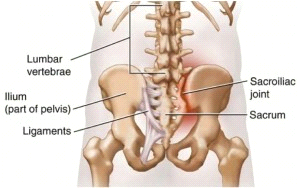What is Sacroiliac Joint Dysfunction?
The sacroiliac joint connects the sacrum (triangular bone at the bottom of the spine) with the pelvis (iliac bone that is part of the hip joint) on each side of the lower spine. It transmits all the forces of the upper body to the pelvis and legs. There is not a lot of motion in the joint and it is very strong and stable.
It is not clearly understood why sacroiliac joint dysfunction occurs, although some believe it is due to a limitation in its normal motion patterns and/or misalignment of the joint. Sacroiliac joint (SI joint) pain typically results in pain on one side very low in the back or in the buttocks. Another term for sacroiliac joint pain is sacroiliitis, a term that describes inflammation in the joint.
Symptoms
SI joint problems are a common cause of low back pain. Additional symptoms may be characterized by the following:
- Pain in the thigh and/or buttock, and possibly pain that radiates down the sciatic nerve, although it rarely radiates into the foot
- More commonly experienced on one side of the body, but may occur on both sides
- More commonly found in young or middle age women.
Causes
While it is not clear how the pain is caused, it is thought that an alteration in the normal joint motion may be the culprit that causes sacroiliac pain. This source of pain can be caused by either:
- Too much movement (hypermobility or instability): The pain is typically felt in the lower back and/or hip and may radiate into groin area.
- Too little movement (hypomobility or fixation): The pain is typically felt on one side of the low back or buttocks, and can radiate down the leg. The pain usually remains above the knee, but at times pain can extend to the ankle or foot. The pain is similar to sciatica, or pain that radiates down the sciatic nerve and is caused by a radiculopathy.
Diagnosis
Accurately diagnosing sacroiliac joint dysfunction can be difficult because the symptoms mimic other common conditions, including other mechanical back pain conditions like facet syndrome as well as other lumbar spine conditions including disc hernation and radiculopathy (pain along the sciatic nerve that radiates down the leg).
In physical examination, the doctor may try to determine if the sacroiliac joint is the cause of pain through movement of the joint. If the movement recreates the patient’s pain, and no other cause of pain can explain the patient’s pain and symptoms (such as a disc herniation on an MRI scan), the sacroiliac joint may be the cause of the pain
There are several orthopedic provocative tests that can be used in an attempt to reproduce the symptoms associated with sacroiliac joint dysfunction. As a rule, several positive tests that reproduce pain specifically located at the sacroiliac joint improves the probability of the diagnosis of sacroiliac joint dysfunction.
For example, a physical exam may consist of the following:
- The patient may lie face up on the edge of an examination table with the leg of the affected side hanging off the side of the table towards the floor or resting on a nearby stool so that the sacroiliac joint lies on the edge of the table.
- The opposite knee can be drawn to the chest to further isolate the SI joint on the side of the hanging leg. In this position, there is no support for the hip joint and pressing down on the iliac crest (pelvis) or upper thigh may reproduce the patient’s pain.
- Care in locating the pain directly over the SI joint is needed as other structures of the lumbar spine and pelvis are also stressed in this position.
Treatments
Tell your patients their first step is to stop any activity that induces pain. SJD can be managed conservatively with a combination of chiropractic adjustments, therapeutic exercise, and custom orthotics when necessary. Custom orthotics can help treat underlying biomechanical abnormalities by stabilizing the joint, allowing patients to more comfortably and safely engage in rehab.
- Manipulation of the SI joint is a logical place to start. A 2004 study found that a short regimen of either mechanical force; manually-assisted; or high-velocity, low-amplitude chiropractic adjustments were equally beneficial in relieving pain and disability in patients with SI joint syndrome.14 Some patients respond better to different approaches, so you may want to employ various manipulations. Myofascial release, trigger point therapy, and acupressure may also be effective.
- Therapeutic exercise can help correct muscular imbalances and relieve stress on the joint. Your patients may also benefit from strengthening exercises targeting the core stabilizer muscles of the spine and those focused on SI-joint stability.
- Custom orthotics or shoe lifts address anatomic or functional leg-length discrepancies and other lower extremity components. These will also help to properly distribute weight borne by the lower back and SI joints for immediate pain relief.
- Supports for the low back and pelvic area such as a cervical support pillow help promote comfort and proper alignment of the spine during sleep.
- Electrical nerve stimulation, ultrasound, heat, cryotherapy, and stretching can be used individually or in combination as part of a targeted physical therapy program.
An ounce of prevention is worth a pound of cure. To prevent their condition from returning, encourage your patients to keep their bodies in good physical condition by maintaining a healthy weight, eating plenty of nutritious foods, and wearing custom-made orthotics to ensure the biomechanics of the body are working properly.



